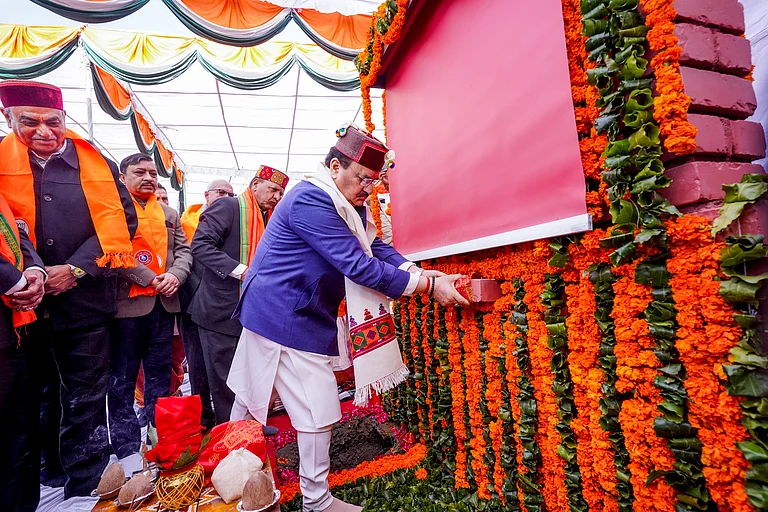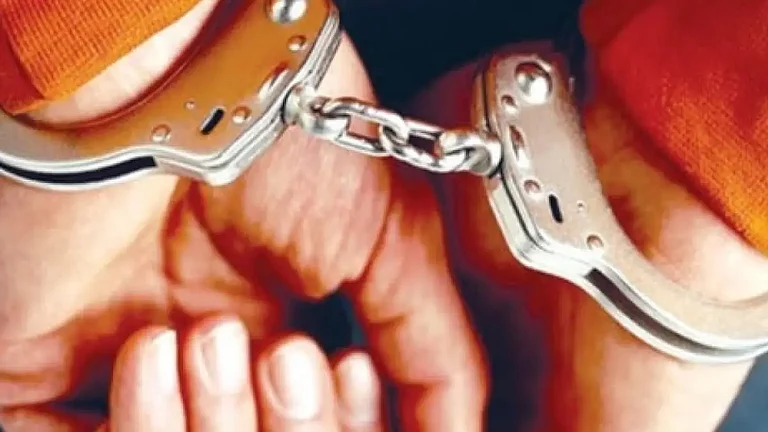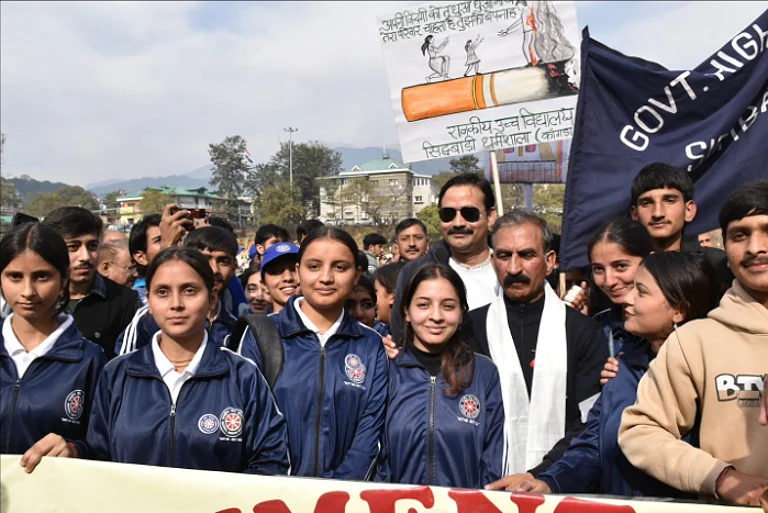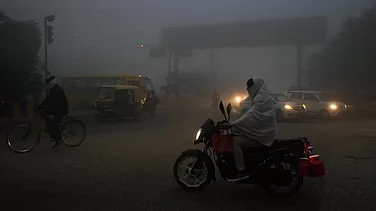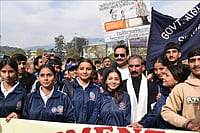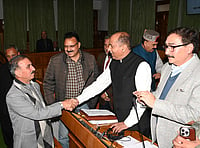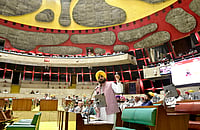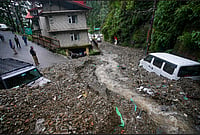The recent cloudbursts, flash floods, landslides, severe devastation and loss of life over the past week, coupled with last year’s monsoon events, have been particularly distressing for Himachal Pradesh. There is clear scientific evidence demonstrating how climate change and human activities have impacted the fragile Himalayan region. Chief Minister Sukhvinder Singh Sukhu acknowledges that the region is warming faster than expected, with significant loss of forest cover, melting of glaciers and frequent extreme weather events. Recognising the 'climate risks' to the state's sustainable growth, Sukhu talks about transforming Himachal Pradesh into a ‘Green state’ by 2026 and achieving economic self-reliance by 2032. In conversation with Outlook’s Ashwani Sharma in Shimla, he discusses the challenges and goals of his government.
There were more than 500 fatalities in 2023 monsoon, massive destruction to public property and immense human miseries. In recent months, there have been a series of cloudbursts again. Can you give a comment?
Himalayas have become the epicentre of climate change impact. Landslides, cloudbursts and flash floods are not new to the mountains. However, the scale and frequency have intensified, resulting in severe human and material losses. A single cloudburst obliterated the village of Sumej on the borders of Shimla and Kullu district last week. We responded swiftly, sanctioned relief and deployed the army, NDRF, CISF, ITBP and police in a search operation to trace 50 missing persons. The catastrophe is certainly big.
Did you try to find reasons behind the unprecedented happenings?
The government is working on measures to minimise the losses but can’t prevent disasters. Last year, we were taken aback as no one could imagine a disaster of such a scale and magnitude. The torrential monsoon rain broke a 100-year-old record and caused a trail of severe devastation. Floods washed away everything that came in the way. Unprecedented landslides wreaked havoc. Hills collapsed taking down the houses and buildings with it. A British-era capital town, Shimla was also shaken. Climate change is certainly a factor but we are also contributing to the disaster.
Don't you think monsoons are turning worse every year because of interference with nature?
I agree to a great extent. Things have changed over the years. Even mountains are under stress due to global warming, deforestation, pollution and haphazard construction. Glaciers are melting faster than expected. Farmers are bearing the brunt of rising temperatures and heat. Monsoon rains invariably turn fearful. Our efforts in Himachal Pradesh are focused on enhancing risk reduction, developing an early warning system and improving preparedness. However, despite these advancements, the mountains are unpredictable and nature is beyond anyone's control. Wayanad tragedy, or Kedarnath and Chamoli floods earlier, are also examples.
What is the solution in your mind to prevent catastrophic losses?
I strongly feel that the centre and state governments, particularly the Himalayan states, have to come together and engage with scientists to think about long-term measures. The state governments can make individual efforts but they don’t have a wherewithal and resources pool. We are also making people aware of how to secure themselves and what should be their response in such situations. Our disaster response system in Himachal Pradesh is quite robust.
How much loss was estimated after the 2023 monsoon disaster?
We suffered very heavy losses estimated at Rs 9,712 crore due to monsoon disasters including floods, relentless rains, landslides and cloudbursts. The human losses were 509. This time again, we are badly hit. A single cloudburst on the Shrikhand mountaintop last week caused widespread destruction in three different directions in Shimla and Kullu districts. Around 50 persons were feared dead. The search for bodies is still on.
What are the key green initiatives currently underway in Himachal Pradesh?
We will convert the entire government fleet to e-vehicles in a phased manner to curb air pollution and reduce carbon footprints. I have recently approved Rs 327 crore funding to transform the Public transport sector into a ‘green transportation system’. More electric buses are being introduced in its existing fleet of 110 e-buses and 50 e-taxis. One solar power plant has already been commissioned and efforts are underway to set up the first green hydrogen plant. We will not use thermal power in the state. My plan is to make Himachal Pradesh a green state energy state by March 31, 2026. We will not allow any polluting industry in the state. There is an open-door policy for eco-friendly investments.
Your government was on the brink of collapse due to a rebellion by Congress MLAs, who also cross-voted in the Rajya Sabha poll.
Six MLAs, who betrayed the party, were disqualified by the Speaker. Unable to get relief from the Supreme Court, they joined the BJP. Only two of them could win in the bypolls. Additionally, three independents, part of the scheme, resigned at the BJP's behest, with only one winning on the BJP ticket. The Congress has regained its original strength of 40 MLAs in the House. In Himachal Pradesh, BJP's attempts to gain power were unsuccessful.
Given that you have consolidated your position, are you prepared to take tough decisions?
Self-reliance is the goal of "Vayvastha Parivartan" (Policy Reforms). To date, Himachal Pradesh has been heavily reliant on loans, with debt reaching unprecedented levels. Each person in the state carries a debt of Rs 1.25 lakh on his head. Given this situation, the state faces a crucial choice: to continue accumulating debt or focus on generating resources. In the first year of implementing policy changes, we managed to raise an additional Rs 2,200 crore, increasing revenue by 20 per cent. The goal for this year is to double these efforts. To achieve economic self-reliance by 2032, I plan to implement measures to reduce administrative costs and introduce comprehensive reforms across all sectors. My vision is clear and I believe in transparency. I will not permit loot of the state's natural resources.
What is the further scope?
I took a major step to impose water cess on hydro-power generation to raise Rs 3,000 cr per annum. Unfortunately, matters went into litigation. Nevertheless, two major decisions of the High Court went in our favour in the case of Wildflower Hall – which was with Oberoi Group – and another Rs 280 cr refund claimed by Adani Group in connection with a high-stakes hydro-power project in Kinnaur. We are determined to get a legitimate free power share raise in three hydro-power projects, which BJP had given to SJVN Ltd without negotiating a higher share of free power. I will take back projects if the Centre refuses to accept our demand.
Why did you decide to cut down power subsidies to taxpayers?
Why should taxpayers receive free electricity? Those who pay income tax can afford to cover their electricity costs. Free electricity scheme for income-tax payers has been scrapped but subsidies will remain only for BPL and IRDP families. The subsidy will not apply to former chief Ministers, speakers, deputy speakers, sitting and former MLAs, MPs, and Class 1 and Class 2 employees. This measure aims to save Rs 700 crore annually for the HP State Electricity Board.
How are your relations with the Centre?
I have been in the chief ministerial post for the past 19 months. My relationship with the central leadership has been good. It is my duty to ensure that the state receives its rightful share of funds on time and that our rights in power projects are not overlooked. Recently, I met with Prime Minister Narendra Modi and Home Minister Amit Shah to discuss state issues. We are also urging the central government to decide on the Rs 9,712 crore in assistance requested following the post-disaster assessment conducted by the central team. Additionally, I have requested the Centre's support in making Himachal Pradesh India’s year-round tourist destination. I also met Union health minister JP Nadda, who also hails from Himachal Pradesh, for liberal help for disaster mitigation and rehabilitation of affected families.







